
'ANARCHY’? COINAGE OF KING STEPHEN'S REIGN
17 September 2019 – 15 December 2019
Hunterian Museum
Admission free
Introduction
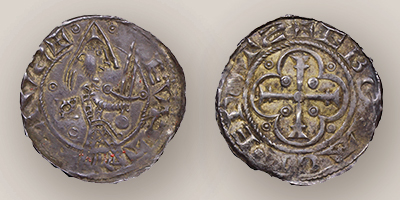 Medieval English kings fiercely preserved their monopoly of the coinage. Coins were crucial to the economy, but also important symbols of royal power. If a monarch couldn’t control the name and image that appeared on coins, what would that say about their authority, and those who usurped royal rights?
Medieval English kings fiercely preserved their monopoly of the coinage. Coins were crucial to the economy, but also important symbols of royal power. If a monarch couldn’t control the name and image that appeared on coins, what would that say about their authority, and those who usurped royal rights?
Control of the coinage famously broke down during the ‘Anarchy’: a civil war between King Stephen (r. 1135-1154) and the Empress Matilda. Alongside Stephen’s issues, Matilda also struck coins, as did individual barons, who may have been taking advantage of the absence of royal authority to build their own autonomous power blocs. Here too we find the first King of Scotland to mint coins, David I.
Coins can sometimes be ignored by historians, but their importance in how we understand the past is very clear from the ‘Anarchy’. Not only does coinage represent the breakdown of power and authority during this period, the variety of issues tell us a considerable amount about its history, how the spectrum of actors thought of themselves and crucially, how they wanted to be seen by others.
William Hunter’s numismatic collection is one of his greatest legacies, with an important series of coins from the ‘Anarchy’. This is the first time that these rare coins have been on display together.
Pictured: Eustace fitzJohn, penny, c.1148 - 1152, silver, York, GLAHM:37700, Hunter.
King Stephen’s Reign: A Brief History
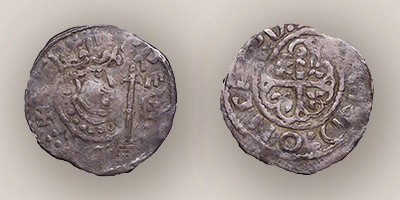 ‘Anarchy’ has been used to describe the reign of King Stephen of England since the 19th century. Between 1138 and 1154, the country was ravaged by a civil war in which contemporary chroniclers report the general population suffered terribly. According to the Anglo-Saxon Chronicle, so hopeless were people that they said that ‘Christ and his angels slept’.
‘Anarchy’ has been used to describe the reign of King Stephen of England since the 19th century. Between 1138 and 1154, the country was ravaged by a civil war in which contemporary chroniclers report the general population suffered terribly. According to the Anglo-Saxon Chronicle, so hopeless were people that they said that ‘Christ and his angels slept’.
Henry I died in 1135. The only surviving child from his first marriage was a daughter, Matilda, whom Henry designated as heir to the throne. As a young girl, Matilda had been married to the Emperor, Henry V. She returned to the Norman realm after the emperor’s death in 1125 and retained her title as Empress.
Henry I was also Duke of Normandy and struggling to defeat an alliance of rebels and neighbouring French principalities. To try and resolve the conflict, he married Matilda to the leader of the most difficult of the latter, Geoffrey Count of Anjou, to establish a family alliance. Henry married again in the hope of having a son, but none were born, so he began to plan for his succession. Twice he required the Norman and English barons to swear to accept Matilda on his death, but they were reluctant. Ruling queens were unheard of and Geoffrey was essentially the hereditary enemy of the Normans. Indeed, when Henry I died, he was at war with Matilda and Geoffrey.
Henry’s nephew, Stephen, one of the king’s favourites and a major landholder in England and Normandy, seized the opportunity to claim the throne of England. Stephen was subsequently accepted as king and Duke of Normandy. Matilda and Geoffrey protested vehemently, but it wasn’t until 1138 that their cause became a real threat. That year, Matilda’s half-brother, Robert, Earl of Gloucester, switched allegiance from Stephen to his sister. The support of Robert, the most important of Henry I’s sons from his other relationships, spurred Matilda to sail to England.
Stephen was captured in 1141. For a brief period, Matilda was acknowledged by many as rightful ruler of the kingdom. She was days away from being crowned in London when Stephen’s queen (also named Matilda), loyal forces and the citizens of London drove the Empress from the city. Thereafter, the civil war descended into stalemate. Matilda and her allies were strong in the south-west of England and Stephen in the south-east, but neither were able to achieve a decisive victory. Matilda’s husband, Geoffrey, managed to complete a take-over of Normandy by 1145, and Matilda returned there three years later.
Geoffrey and Matilda’s son, Henry, took over the cause. Not only was he a man rather than a woman, he was a hugely charismatic young knight and the husband of Eleanor of Aquitaine, possibly the most famous and powerful woman of her time (Henry was Eleanor’s second husband, she and the King of France had just divorced). Henry was also an extremely effective negotiator. Between 1149 and 1153, he persuaded English barons loyal to Stephen to switch sides.
By 1153, Queen Matilda, very much Stephen’s most important supporter, had died. Also dead was Stephen’s eldest son and hoped-for heir to the throne, Eustace. An agreement was reached whereby Stephen would rule until his death and Henry would then succeed to the throne. Stephen began to rebuild royal authority and, on his death in 1154, Henry duly took the throne as Henry II. This narrative is reflected in the coinage of Stephen, Matilda and Henry II.
Pictured: Stephen, penny, 1135 – 1154, silver, Carlisle, GLAHM:35468, purchase 1987.
Coinage in the 12th Century
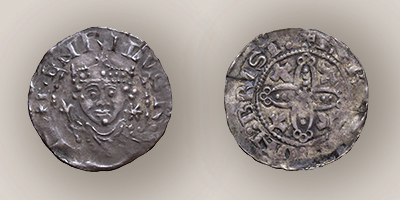 In the 12th century, coins were minted by individual moneyers across England. Their names and the towns where they worked were included in the inscription on the reverse of the coins. On the obverse was the king’s head and title. Moneyers paid the king fees to strike coinage and for the dies used to hammer out individual coins. Dies were changed every few years to maintain control and quality of the coinage. Monarchs took these responsibilities seriously. Mercenaries hired by Henry I once refused to be paid in English coin because they doubted its quality. The king then ordered that every moneyer in England should have both his right hand and testicles amputated as punishment.
In the 12th century, coins were minted by individual moneyers across England. Their names and the towns where they worked were included in the inscription on the reverse of the coins. On the obverse was the king’s head and title. Moneyers paid the king fees to strike coinage and for the dies used to hammer out individual coins. Dies were changed every few years to maintain control and quality of the coinage. Monarchs took these responsibilities seriously. Mercenaries hired by Henry I once refused to be paid in English coin because they doubted its quality. The king then ordered that every moneyer in England should have both his right hand and testicles amputated as punishment.
Pictured: Henry I, penny, 1100 – 1135, silver, Bristol, Hunter.
The King’s Coinage: Collapse, Restoration and Propaganda
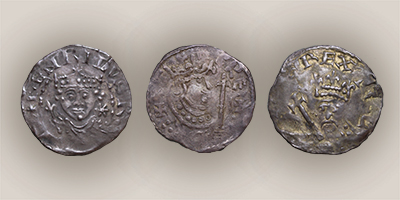 Stephen issued seven ‘types’ of pennies through his reign. Only two of them, types 1 and 7, issued at the beginning and end of his reign, before and after the civil war, were struck by moneyers working in towns across his realm. Henry II’s early coins were also issued by mints across the country and were very similar to Stephen’s. This illustrates the commitment to the restoration of royal authority after the civil war, and, together with coins of Henry I, the continuity of royal government.
Stephen issued seven ‘types’ of pennies through his reign. Only two of them, types 1 and 7, issued at the beginning and end of his reign, before and after the civil war, were struck by moneyers working in towns across his realm. Henry II’s early coins were also issued by mints across the country and were very similar to Stephen’s. This illustrates the commitment to the restoration of royal authority after the civil war, and, together with coins of Henry I, the continuity of royal government.
Types 2 to 6 of Stephen’s pennies were struck mostly in the south-east, the only region where his government retained control throughout the civil war. Elsewhere, other mints continued to issue type 1 pennies, which historians have often interpreted as representing residual local loyalty to Stephen and a commitment to maintaining the structures of his kingdom.
Non-standard coins of the king were also issued, possibly by moneyers suggesting how power was really working in the kingdom, or perhaps because Stephen and his government wanted to convey particular messages to the population.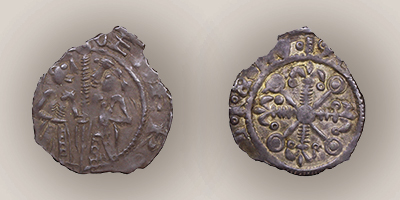 Opinion is split as to whether the figure on the right of this coin is Stephen’s wife, Queen Matilda, or his eldest son, Eustace. The queen was countess of Boulogne (now in France) in her own right. Boulogne was a wealthy trading centre and it has been suggested that the queen funded Stephen’s campaigns. As the daughter of Malcolm Canmore and Margaret of Scotland, she was not only connected to King David of Scotland (he was her uncle), but also of Anglo-Saxon royal blood. When Stephen was captured in 1141, it was the queen who maintained his cause and she can often be found at his side. If this figure is Queen Matilda, then not only does it represent her importance, but it is also the only time a queen consort appears on a British coin.
Opinion is split as to whether the figure on the right of this coin is Stephen’s wife, Queen Matilda, or his eldest son, Eustace. The queen was countess of Boulogne (now in France) in her own right. Boulogne was a wealthy trading centre and it has been suggested that the queen funded Stephen’s campaigns. As the daughter of Malcolm Canmore and Margaret of Scotland, she was not only connected to King David of Scotland (he was her uncle), but also of Anglo-Saxon royal blood. When Stephen was captured in 1141, it was the queen who maintained his cause and she can often be found at his side. If this figure is Queen Matilda, then not only does it represent her importance, but it is also the only time a queen consort appears on a British coin.
Towards the end of his reign, Stephen was desperate to have his son Eustace recognised as heir to the throne. He insisted his barons take an oath of loyalty to Eustace and sought to have him crowned. This was traditional in France, but not in England, and the Church, through the papacy, had prohibited changes to royal succession practices as part of its recognition of Stephen’s right to hold the throne. Since only the Church could crown and consecrate a king, this was a major problem for Stephen. If the right-hand figure is a man, then this coin may represent part of Stephen’s campaign to have his son recognised.
Pictured: Top (left to right): Henry I, penny, 1100 – 1135, silver, Bristol, Hunter; Stephen, penny, 1135 – 1154, silver, Carlisle, GLAHM:35468, purchase 1987; Henry II, penny, 1154 – 1189, silver, Canterbury, Hunter. Bottom: Stephen, penny, 1135 – 1154, silver, York, GLAHM:37698, Hunter.
Empress Matilda: Queenship Claimed and Queenship Lost
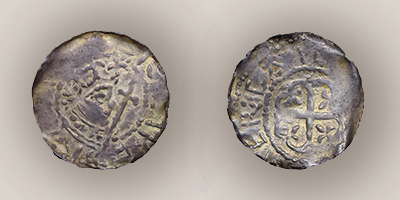 In 1141, with Stephen captured and powerful Church leaders committed to trying to bring the civil war to an end, Matilda’s claim to the throne became a reality. She was accepted as ‘Lady’ of England and preparations got underway for her coronation as queen. Her documents took on royal styles and coins in her name began to be issued.
In 1141, with Stephen captured and powerful Church leaders committed to trying to bring the civil war to an end, Matilda’s claim to the throne became a reality. She was accepted as ‘Lady’ of England and preparations got underway for her coronation as queen. Her documents took on royal styles and coins in her name began to be issued.
Contemporary chroniclers accuse Matilda of arrogance and not listening to the advice of her most important supporters, who she quickly alienated. Matilda also refused to listen to pleas by Queen Matilda and churchmen to allow Stephen’s children to maintain lands and titles, and by the citizens of London to maintain governmental and taxation privileges. Not only did these decisions impact on Stephen’s family and Londoners, they broadcast a wider message. Stephen loyalists may have felt they were being told that there was no way back for them with the new regime. Advisers began to slip away. Queen Matilda rallied royal forces and allied with Londoners to drive the Empress from the city. Stephen was later released in an exchange of hostages. Empress Matilda’s chance of becoming queen had passed.
Historians have frequently debated the extent to which Empress Matilda was to blame for her fate. It has been argued that accusations of arrogance and ignoring advice would not have been made against a male ruler - similar actions might even have been praised as strong rulership. If this is the case, then the fact that Matilda was a woman was the crux of the matter. On the other hand, Empress Matilda’s son, Henry, agreed to Stephen’s surviving son holding on to his family resources. Additionally, all Norman kings before and after Matilda were keen to negotiate with the Londoners. Henry sent a clear message to Stephen loyalists that if compromises could be sought, they would not be outcasts. If this was the case, then perhaps Matilda was indeed at fault in 1141.
Pictured: Empress Matilda, penny, c.1141 - 1142, silver, Cardiff, GLAHM:37697, purchase 1981.
Baronial Pennies and the ‘Anarchy’
 According to the chronicler William of Newburgh, ‘… in England there were in a sense as many kings, or rather tyrants, as there were lords of castles. Each minted his own coinage, and each, like a king, had the power to lay down the law for his subjects’.
According to the chronicler William of Newburgh, ‘… in England there were in a sense as many kings, or rather tyrants, as there were lords of castles. Each minted his own coinage, and each, like a king, had the power to lay down the law for his subjects’.
The Anglo-Saxon Chronicle used similar words: ‘… every powerful man built his castles… When the castles were built they filled them with devils and wicked men… They levied taxes on the villages every so often, and called it ‘protection money’. When the wretched people had no more to give, they robbed and burned the villages…’
During the civil war, royal authority in England was weak and government had a limited reach outside south-east England. A number of barons seem to have taken advantage of this, and the need of both Stephen and Matilda to seek allies, to expand and increase their own power, paying little attention to the royal conflict.
For some historians, these barons were seeking to fundamentally change the nature of the kingdom of England, creating autonomous power centres only loosely governed by any future king (much like some held already in Normandy). It is the actions of such men which have been called ‘Anarchy’.
For other historians, barons looked forward to a return of strong kingship and only undertook these actions because they had to – if these strong figureheads didn’t take on more authority and protect themselves, they, their lands and those who resided in them would have been subject to great dangers.
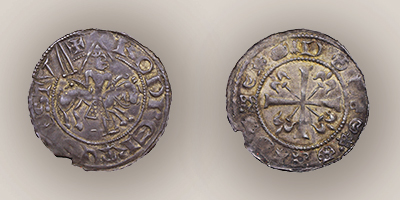 Coins minted by some of these barons, with their own symbols in place of the king’s portrait, have long been part of both sides of this debate. Their coinage could represent the usurping of rights and status of the king, or an attempt to maintain structures of governance and authority in the king’s absence. Either way, the symbols they chose to promote their power demonstrate exactly what it was rooted in - violence.
Coins minted by some of these barons, with their own symbols in place of the king’s portrait, have long been part of both sides of this debate. Their coinage could represent the usurping of rights and status of the king, or an attempt to maintain structures of governance and authority in the king’s absence. Either way, the symbols they chose to promote their power demonstrate exactly what it was rooted in - violence.
Two the coins on display are baronial pennies, one issued by Eustace fitzJohn and one by Robert de Stuteville. Eustace fitzJohn was called by the chronicler Roger of Howden, a ‘one-eyed vile traitor’. He was based at Alnwick, near the Scottish border, joining David I and his son, Prince Henry, in raiding England. He also fought on the Scottish side at the Battle of the Standard in 1138, after which Stephen deprived him of his estates. Nevertheless, Scottish connections, two wealthy wives and political astuteness made fitzJohn extremely powerful. He died in battle in Wales in 1157 whilst campaigning with Stephen’s successor, Henry II.
Robert de Stuteville was a Yorkshire baron. He had fought for Stephen at the Battle of the Standard in 1138 against David I of Scotland and would later proclaim loyalty to Henry II, becoming one of the leaders of the English army which captured William the Lion in 1174.
Pictured: Top: Eustace fitzJohn, penny, c.1148 - 1152, silver, York, GLAHM:37700, Hunter. Bottom: Robert de Stuteville, penny, c.1148 - 1152, silver, York, GLAHM:37699, Hunter.
Scotland’s First Coins
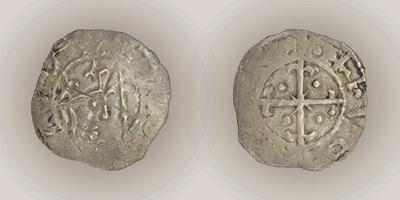 David I of Scotland (r. 1124-1153) has long been recognised as the crucial figure in the development of the medieval Scottish kingdom, its government structures and systems. With the collapse of royal authority in England, David took the opportunity to expand into northern England, in particular Cumbria and Northumberland, to which he had prior claims. David’s son, Prince Henry, was subsequently recognised as Earl of Northumberland by Stephen.
David I of Scotland (r. 1124-1153) has long been recognised as the crucial figure in the development of the medieval Scottish kingdom, its government structures and systems. With the collapse of royal authority in England, David took the opportunity to expand into northern England, in particular Cumbria and Northumberland, to which he had prior claims. David’s son, Prince Henry, was subsequently recognised as Earl of Northumberland by Stephen.
David was uncle to both Empress Matilda and Stephen’s Queen Matilda. He had also been a favourite of his brother-in-law, Henry I, and a major English landholder. David was willing to work closely with Stephen at first, but when Matilda arrived in England in 1138, he sided with her.
One of the benefits of taking over Cumbria was control of the most important silver mines in Britain, at Alston. From here, silver was drawn for the first Scottish pennies, with mints at Berwick, Carlisle, Edinburgh and Roxburgh.
Pictured: David I, penny, c.1150, silver, Roxburgh, GLAHM:14513, Cuthbert.
Events
Hunterian Insight Talks
These talks take place in the Hunterian Museum at 1.00pm.
Talks last approximately 10-15 minutes with time for questions afterwards.
Tuesday 15 October
Empress and Queen: Gender Representation and the Coins of the Anarchy of Stephen's Reign
Callum Jamieson
Tuesday 12 November
Coins of the Anarchy of Stephen's Reign
Dr. Stephen Marritt
Tuesday 10 December
'Anarchists': The Coins of Barons of Stephen's Reign
Ross Kennedy
Blog
Three posts related to the 'Anarchy'? by Dr Stephen Marritt, Lecturer in History at the University of Glasgow, are available now on The Hunterian Blog site:
Further Reading
The most important (and readable) study of Stephen’s coinage is: M. Blackburn, ‘Coinage and Currency’ in The Anarchy of King Stephen’s Reign, ed. E, King (Oxford, 1994), pp. 145-206. A new survey incorporating all the most recent work in this field is: Benjamin Fairbairn, King Stephen's reign: a reassessment of the Numismatic evidence, Numismatic Journal, 87 (2017), 43-54.
For the civil war and the reign itself, a good starting point is: C. Watkins, Stephen: The Reign of Anarchy (London, 2015). If you want to delve deeper, the best study of the whole reign is still: D. Crouch, The Reign of King Stephen 1135-54 (London, 2000). And the best biography of the king: E. King, King Stephen (London, 2010). For the Empress Matilda, we only have one full biography: M. Chibnall, The Empress Matilda (Oxford, 1991). See also for a recent consideration of her coinage: J. Porter, ‘A new coin type of the Empress Matilda?: The “rex Matilda” Cross Moline type’, British Numismatic Journal, 89 (2019), 10-127, which is set in a wider context in: S. Church, ‘Succession and Interregnum in the English Polity: the case of 1141’, Haskins Society Journal, 29 (2018), 181-200.
For King David of Scotland, see: R. Oram, David I: The King who made Scotland (Stroud, 2004).
The best place to look for some of the key barons of Stephen’s reign is the Oxford Dictionary of National Biography, (though Wikipedia also has some good entries). In addition to Eustace and Robert, especially interesting are Ranulf Earl of Chester; Robert Earl of Gloucester; William Earl of York and Geoffrey de Mandeville.
Acknowledgements
- Dr Stephen Marritt, Lecturer in History, University of Glasgow
- Cameron Maclean
- Staff of The Hunterian, in particular Chris MacLure and Harriet Gaston

